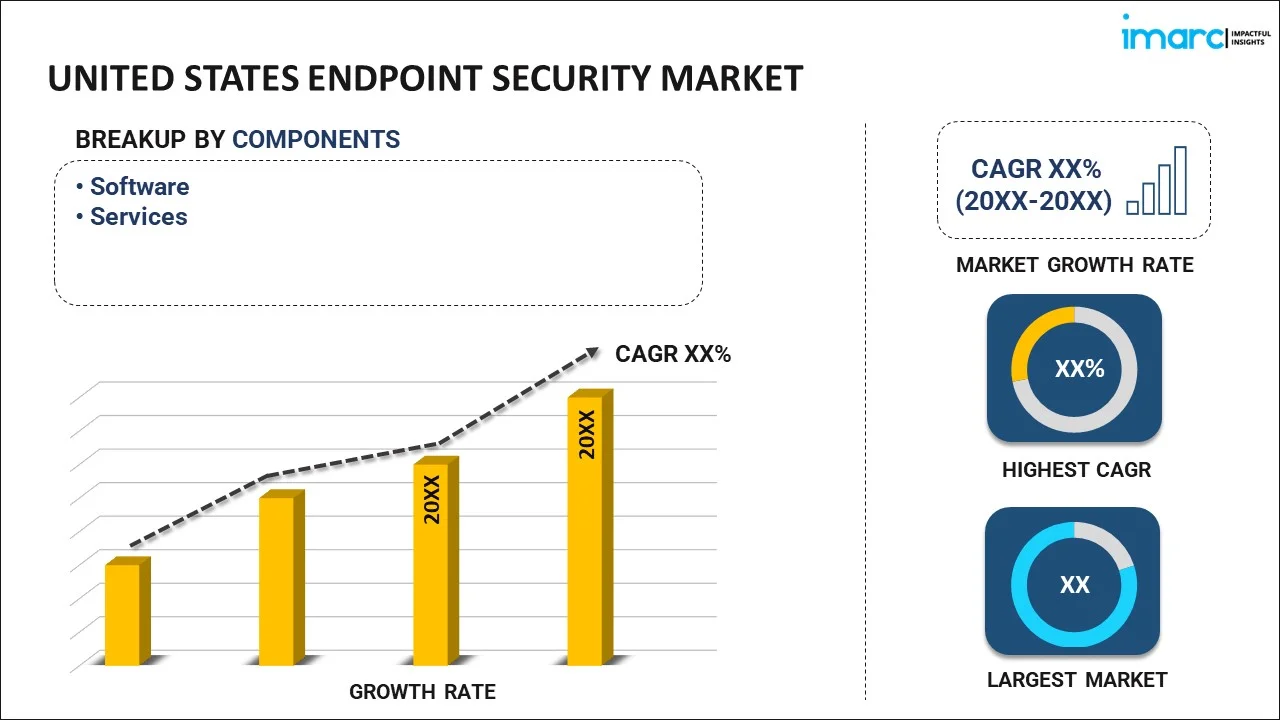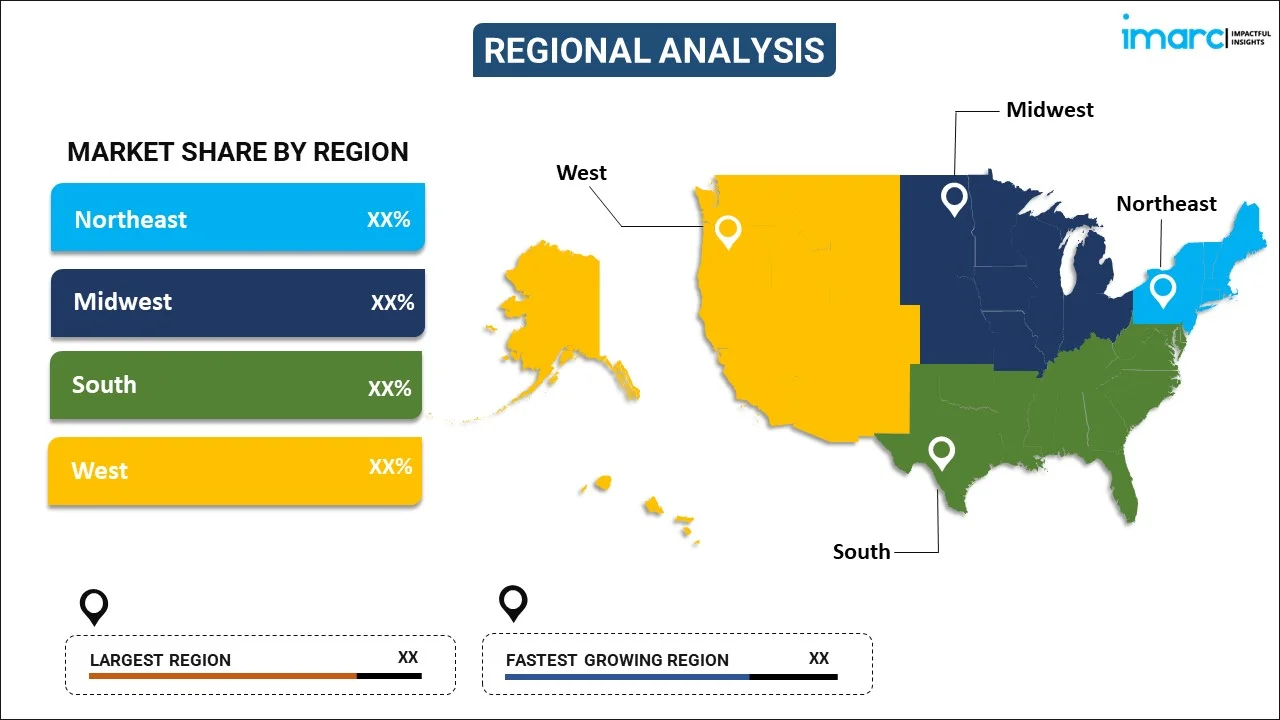
United States Endpoint Security Market Report by Component (Software, Services), Deployment Mode (On-premises, Cloud-based), Organization Size (Large Enterprises, Small and Medium-sized Enterprises), Vertical (Banking, Financial Services and Insurance (BFSI), IT and Telecommunications, Government and Defense, Healthcare and Life Sciences, Manufacturing, Retail and E-Commerce, and Others), and Region 2025-2033
Market Overview:
United States endpoint security market size reached USD 6.3 Billion in 2024. Looking forward, IMARC Group expects the market to reach USD 17.0 Billion by 2033, exhibiting a growth rate (CAGR) of 10.7% during 2025-2033. The increasing prevalence of cybersecurity threats, such as malware, the growing complexity of IT infrastructure, the expansion of remote work and the use of personal devices represent some of the key factors driving the market.
|
Report Attribute
|
Key Statistics
|
|---|---|
|
Base Year
|
2024
|
|
Forecast Years
|
2025-2033
|
|
Historical Years
|
2019-2024
|
| Market Size in 2024 | USD 6.3 Billion |
| Market Forecast in 2033 | USD 17.0 Billion |
| Market Growth Rate 2025-2033 | 10.7% |
Endpoint security refers to the methods and technologies used to protect a network by securing its endpoint devices, including computers, mobile phones, and tablets that connect to the network. As the number of devices per user within organizations grows, and with the increasing prevalence of remote work, endpoint security has become a critical aspect of an organization's overall cybersecurity strategy. Endpoint security solutions are designed to detect, analyze, and respond to threats targeting these devices. Traditional antivirus software is a part of this, but modern endpoint security encompasses a broader range of tools and techniques. This includes advanced threat prevention, such as next-generation antivirus (NGAV), endpoint detection and response (EDR), and unified endpoint management (UEM) systems. These technologies provide comprehensive protection against malware, ransomware, phishing attacks, and other sophisticated threats. It employs predictive analytics and machine learning algorithms to identify and neutralize potential risks before they cause harm. This approach is crucial in combating the ever-evolving landscape of cyber threats.
United States Endpoint Security Market Trends:
The increasing prevalence of cybersecurity threats, such as malware, ransomware, and phishing attacks, is driving the market in the United States. These threats have become more sophisticated and frequent, prompting organizations to prioritize endpoint security solutions that can effectively detect, prevent, and respond to these risks. Moreover, the expansion of remote work and the use of personal devices for professional purposes, commonly known as bring your own device (BYOD), is supporting the growth of the market. This trend has expanded the attack surface for cyber threats, making endpoint security a crucial component of an organization's cybersecurity strategy. Endpoint security solutions provide necessary controls to manage and secure devices accessing corporate networks, thereby reducing the risk of data breaches and cyberattacks. Besides, compliance requirements and regulatory standards also play a significant role. Various industries, such as healthcare, finance, and government, are subject to strict data protection regulations, including HIPAA, GLBA, and FISMA. These regulations mandate stringent security measures, including endpoint protection, to safeguard sensitive information. Failure to comply can result in substantial fines and reputational damage, driving organizations to invest in robust endpoint security solutions. Furthermore, the rapid technological advancements and integration of artificial intelligence (AI) and machine learning (ML) in endpoint security solutions are also fueling market growth. These technologies enhance the effectiveness of security solutions by enabling real-time threat detection, automated responses, and predictive analytics. They provide an additional layer of security by identifying and responding to threats that traditional security measures might miss. Besides, the increasing complexity of IT infrastructure, with a mix of cloud and on-premises solutions, necessitates more advanced and integrated endpoint security solutions. As organizations adopt cloud services and virtualization, the need for security solutions that can operate effectively in these environments becomes imperative. Endpoint security providers are continuously evolving their offerings to address these complex environments, making their solutions more attractive to businesses.
United States Endpoint Security Market Segmentation:
IMARC Group provides an analysis of the key trends in each segment of the market, along with forecasts at the country level for 2025-2033. Our report has categorized the market based on component, deployment mode, organization size, and vertical.
Component Insights:

- Software
- Services
The report has provided a detailed breakup and analysis of the market based on the component. This includes software and services.
Deployment Mode Insights:
- On-premises
- Cloud-based
A detailed breakup and analysis of the market based on deployment mode have also been provided in the report. This includes on-premises and cloud-based.
Organization Size Insights:
- Large Enterprises
- Small and Medium-sized Enterprises
The report has provided a detailed breakup and analysis of the market based on the organization size. This includes large enterprises and small and medium-sized enterprises.
Vertical Insights:
- Banking, Financial Services and Insurance (BFSI)
- IT and Telecommunications
- Government and Defense
- Healthcare and Life Sciences
- Manufacturing
- Retail and E-Commerce
- Others
A detailed breakup and analysis of the market based on vertical have also been provided in the report. This includes banking, financial services and insurance (BFSI), IT and telecommunications, government and defense, healthcare and life sciences, manufacturing, retail and e-commerce, and others.
Regional Insights:

- Northeast
- Midwest
- South
- West
The report has also provided a comprehensive analysis of all the major regional markets, which include the Northeast, Midwest, South, and West.
Competitive Landscape:
The market research report has also provided a comprehensive analysis of the competitive landscape in the market. Competitive analysis such as market structure, key player positioning, top winning strategies, competitive dashboard, and company evaluation quadrant has been covered in the report. Also, detailed profiles of all major companies have been provided.
United States Endpoint Security Market Report Coverage:
| Report Features | Details |
|---|---|
| Base Year of the Analysis | 2024 |
| Historical Period | 2019-2024 |
| Forecast Period | 2025-2033 |
| Units | Billion USD |
| Scope of the Report | Exploration of Historical Trends and Market Outlook, Industry Catalysts and Challenges, Segment-Wise Historical and Future Market Assessment:
|
| Components Covered | Software, Services |
| Deployment Modes Covered | On-premises, Cloud-based |
| Organization Sizes Covered | Large Enterprises, Small and Medium-sized Enterprises |
| Verticals Covered | Banking, Financial Services and Insurance (BFSI), IT and Telecommunications, Government and Defense, Healthcare and Life Sciences, Manufacturing, Retail and E-Commerce, Others |
| Regions Covered | Northeast, Midwest, South, West |
| Customization Scope | 10% Free Customization |
| Post-Sale Analyst Support | 10-12 Weeks |
| Delivery Format | PDF and Excel through Email (We can also provide the editable version of the report in PPT/Word format on special request) |
Key Questions Answered in This Report:
- How has the United States endpoint security market performed so far and how will it perform in the coming years?
- What has been the impact of COVID-19 on the United States endpoint security market?
- What is the breakup of the United States endpoint security market on the basis of component?
- What is the breakup of the United States endpoint security market on the basis of deployment mode?
- What is the breakup of the United States endpoint security market on the basis of organization size?
- What is the breakup of the United States endpoint security market on the basis of vertical?
- What are the various stages in the value chain of the United States endpoint security market?
- What are the key driving factors and challenges in the United States endpoint security?
- What is the structure of the United States endpoint security market and who are the key players?
- What is the degree of competition in the United States endpoint security market?
Key Benefits for Stakeholders:
- IMARC’s industry report offers a comprehensive quantitative analysis of various market segments, historical and current market trends, market forecasts, and dynamics of the United States endpoint security market from 2019-2033.
- The research report provides the latest information on the market drivers, challenges, and opportunities in the United States endpoint security market.
- Porter's five forces analysis assist stakeholders in assessing the impact of new entrants, competitive rivalry, supplier power, buyer power, and the threat of substitution. It helps stakeholders to analyze the level of competition within the United States endpoint security industry and its attractiveness.
- A competitive landscape allows stakeholders to understand their competitive environment and provides an insight into the current positions of key players in the market.
Need more help?
- Speak to our experienced analysts for insights on the current market scenarios.
- Include additional segments and countries to customize the report as per your requirement.
- Gain an unparalleled competitive advantage in your domain by understanding how to utilize the report and positively impacting your operations and revenue.
- For further assistance, please connect with our analysts.
 Request Customization
Request Customization
 Speak to an Analyst
Speak to an Analyst
 Request Brochure
Request Brochure
 Inquire Before Buying
Inquire Before Buying




.webp)




.webp)












